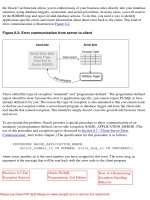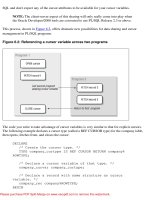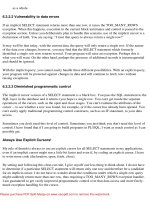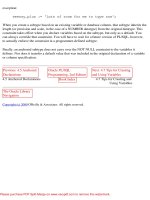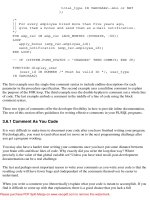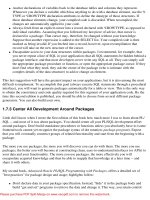html5 pocket reference, 5th edition
Bạn đang xem bản rút gọn của tài liệu. Xem và tải ngay bản đầy đủ của tài liệu tại đây (33.81 MB, 184 trang )
www.it-ebooks.info
www.it-ebooks.info
FIFTH EDITION
HTML5
Pocket Reference
Jennifer Niederst Robbins
Beijing
•
Cambridge
•
Farnham
•
Köln
•
Sebastopol
•
Tokyo
Downloa d f r o m W o w ! e B o o k < w w w.woweb o o k . c o m >
www.it-ebooks.info
HTML5 Pocket Reference, Fifth Edition
by Jennifer Niederst Robbins
Copyright © 2013 Littlechair, Inc. All rights reserved.
Printed in the United States of America.
Published by O’Reilly Media, Inc., 1005 Gravenstein Highway North,
Sebastopol, CA 95472.
O’Reilly books may be purchased for educational, business, or sales promo-
tional use. Online editions are also available for most titles (ari
booksonline.com). For more information, contact our corporate/institutional
sales department: 800-998-9938 or
Editors: Simon St. Laurent and Meghan Blanchette
Production Editor: Kristen Borg
Proofreader: Amanda Kersey
Indexer: Lucie Haskins
Cover Designer: Karen Montgomery
Interior Designer: David Futato
January 2000: First Edition.
January 2002: Second Edition.
May 2006: Third Edition.
December 2009: Fourth Edition.
August 2013: Fifth Edition.
Revision History for the Fifth Edition:
2013-07-19 First release
See for release de-
tails.
Nutshell Handbook, the Nutshell Handbook logo, and the O’Reilly logo are
registered trademarks of O’Reilly Media, Inc. HTML5 Pocket Reference, the
image of a koala, and related trade dress are trademarks of O’Reilly Media,
Inc.
Many of the designations used by manufacturers and sellers to distinguish
their products are claimed as trademarks. Where those designations appear
in this book, and O’Reilly Media, Inc., was aware of a trademark claim, the
designations have been printed in caps or initial caps.
While every precaution has been taken in the preparation of this book, the
publisher and author assume no responsibility for errors or omissions, or for
damages resulting from the use of the information contained herein.
ISBN: 978-1-449-36335-2
[M]
1374005900
www.it-ebooks.info
Contents
HTML5 Pocket Reference 1
HTML5 Overview 2
HTML5 Global Attributes 9
Alphabetical List of Elements 14
Elements Organized by Function 154
A: Character Entities 157
B: XHTML Syntax Overview 165
Index 167
iii
www.it-ebooks.info
www.it-ebooks.info
HTML5 Pocket Reference
HTML (HyperText Markup Language) is the markup language
used to turn text documents into web pages and applications.
The fundamental purpose of HTML as a markup language is
to provide a semantic description (the meaning) of the content
and establish a document structure (a hierarchy of elements).
This pocket reference provides a concise yet thorough listing
of the elements and attributes specified in the HTML5 Candi-
date Recommendation maintained by the World Wide Web
Consortium (W3C) dated December 17, 2012, the HTML 5.1
Editor’s Draft dated June 15, 2013, and the “living” HTML
specification maintained by the Web Hypertext Application
Technology Working Group (WHATWG) as of June 15, 2013.
Elements and attributes from the HTML 4.01 Specification
that were made obsolete in HTML5 have been omitted from
this edition. The elements and attributes contained in this book
may be used in HTML 4.01, XHTML 1.0, or XHTML 1.1
documents, unless they are explicitly marked “Not in HTML
4.01,” in which case they will cause the document to be invalid.
HTML5 documents can be written in XHTML syntax (for-
mally known as the “XML Serialization of HTML5”), so when-
ever applicable, special considerations for XHTML will be
noted. See Appendix B at the end of this reference for details
on XHTML syntax requirements.
1
www.it-ebooks.info
This book is organized into the following sections:
• HTML5 Overview
• HTML5 Global Attributes
• Alphabetical List of Elements
• Elements Organized by Function
• Appendix A, Character Entities
• Appendix B, XHTML Syntax Overview
HTML5 Overview
HTML5 offers new features (elements, attributes, event han-
dlers, and APIs) for easier web application development and
more sophisticated form handling.
The HTML5 specification is based on HTML 4.01 Strict, but
unlike previous HTML Recommendations, HTML5 does not
use a Document Type Definition (DTD). Instead, it uses the
Document Object Model (DOM, the “tree” formed by a docu-
ment’s structure) as its basis rather than a particular set of syn-
tax rules. It also differs from previous recommendations in that
it includes detailed instructions for how browsers should han-
dle malformed and legacy markup.
W3C and WHATWG
There are two organizations maintaining slightly different
HTML specifications as of this writing.
HTML5 was originally written by the Web Hypertext Appli-
cation Technology Working Group (WHATWG). In 2003,
members of Apple, Mozilla, and Opera formed the WHATWG
to further the development of HTML in a way that was con-
sistent with real-world authoring practices and browser be-
havior. Their initial documents, Web Applications 1.0 and
Web Forms 1.0, were rolled together into HTML5, which is
still in development under the guidance of WHATWG editor,
Ian Hickson. They eventually dropped the version number and
2 | HTML5 Pocket Reference
www.it-ebooks.info
now maintain “living” (unnumbered) HTML specification at
whatwg.org.
In 2006, the World Wide Web Consortium (W3C) formed its
own HTML5 Working Group based on the work by the
WHATWG. In 2009, it discontinued its work on XHTML 2.0
in order to focus on the development of HTML5. The W3C
maintains a “snapshot” (numbered) version of HTML5
(www.w3.org/TR/html5/), which is expected to reach Recom-
mendation status in 2014. HTML5.1 is also in development
and is scheduled to become a Recommendation in 2016.
Nightly builds of the HTML5.1 Editor’s Draft are available at
www.w3.org/html/wg/drafts/html/master/.
The differences between the W3C and HTML5 Candidate
Recommendation and the WHATWG versions are fairly mi-
nor. The WHATWG and HTML5.1 spec change frequently,
but the differences as of this writing include:
WHATWG only
ping attribute on a and area elements
srcset attribute on img element
WHATWG and W3C HTML5.1 only
data element
menuitem element
dialog element
main element
inert global attribute
itemid, itemprop, itemref, itemscope, and itemtype global
attributes
onclose and onsort global event handlers
download attribute on a and area elements
sortable attribute on table element
sorted attribute on th element
HTML5 Overview | 3
www.it-ebooks.info
W3C HTML5 only
command element (replaced by menuitem)
media attribute on a element
pubdate attribute on time element
New Semantic Elements in HTML5
HTML5 includes new semantic elements for marking up page
content. Details for each of these elements are provided in the
section “Alphabetical List of Elements” on page 14:
article figcaption output
aside figure progress
audio footer rp
bdi header rt
canvas hgroup* ruby
command* keygen section
data** main** source
datalist mark time
details menuitem** track
dialog** meter video
embed nav wbr
* Removed from HTML5.1
** WHATWG and HTML5.1 only
New input types
HTML5 introduces the following new input control types (in-
dicated as values for the type attribute for the input element):
color, date, datetime, datetime-local, email, month, number,
range, search, tel, time, url, and week.
4 | HTML5 Pocket Reference
www.it-ebooks.info
Obsolete HTML 4.01 elements
The following HTML 4.01 elements were made obsolete in
HTML5 because they were presentational, confusing, or
poorly supported: acronym, applet, basefont, big, center, dir,
frame, frameset, font, isindex, noframes, strike, and tt.
HTML5 APIs
With a growing demand for interactive content on web pages,
HTML5 introduces many APIs (Application Programming In-
terfaces) for the creation of web applications. APIs standardize
tasks that traditionally required proprietary plug-ins or custom
programming. Some have markup components such as audio,
video, and canvas; others only use JavaScript and/or server-side
components.
The following APIs are part of the W3C HTML5 specification:
• Media API, for playback of video and audio files with
multimedia synchronization and timed subtitles, used
with the new video and audio elements (bit.ly/17EC8HT
and bit.ly/13xEOBr)
• TextTrack, for adding timed subtitles and captions for
video and audio elements (bit.ly/16ZQm6S)
• Session History API, for exposing the browser history
(bit.ly/12iDo0Q)
• Offline Web Applications API, which allows web re-
sources to be used while offline (bit.ly/108K1mp)
• Editing API, including a new global contenteditable
attribute (bit.ly/11Tw0Tv)
• Drag and Drop API, including the new draggable
attribute (bit.ly/18sdPhs)
HTML5 Overview | 5
www.it-ebooks.info
Other HTML5-related APIs have separate specifications,
including:
• Canvas API for two-dimensional drawing in conjunction
with the new canvas element (bit.ly/17ftf5F)
• Web Storage API allows data to be stored in the
browser’s cache so an app can use it later (bit.ly/168vZjW)
• Geolocation API lets users share longitude and latitude
information for so they are accessible to scripts in web
applications (bit.ly/168w5rQ)
• Web Workers API that allows scripts to run in the back-
ground to improve performance (bit.ly/17ECwWI)
• Web Sockets API that maintains an open connection be-
tween the client and the server so data can pass between
them in real time. This may be useful for multi-player
games, chat, and live data streams (bit.ly/13UfWUK).
• File API gives access to files uploaded from a form input.
It enables previews of the uploaded file to be shown and
enables drag-and-drop uploading (bit.ly/11sTkro).
This is only a handful of the dozens of APIs in development.
The following resources provide thorough lists of available
APIs and other web technologies in an easy-to-use manner:
• The Web Platform: Browser Technologies, maintained by
Mike Smith of the W3C (platform.html5.org)
• HTML5 Landscape Overview, by Erik Wilde (dret.type-
pad.com/dretblog/html5-api-overview.html)
• Web Platform Docs (docs.webplatform.org/wiki/apis)
HTML5 Document Structure
HTML5 has only one version and does not reference a DTD,
but HTML5 documents still require a simplified DOCTYPE
declaration to trigger standards mode rendering in browsers.
The following is the minimum recommended structure of a
basic HTML5 document:
6 | HTML5 Pocket Reference
Downloa d f r o m W o w ! e B o o k < w w w.woweb o o k . c o m >
www.it-ebooks.info
<!DOCTYPE html>
<html>
<head>
<title>Document Title</title>
</head>
<body>
Content of document . . .
</body>
</html>
HTML5 documents written in XML syntax do not require a
DOCTYPE but may include an XML declaration. They should
also be served as the MIME type application/xhtml+xml or
application/xml. The following is a simple HTML5 document
written in the XML syntax:
<?xml version="1.0" encoding="UTF-8"?>
<html xmlns=" /> <head>
<title>Document Title</title>
</head>
<body>
Content of document . . .
</body>
</html>
HTML5 Browser Support
Most of the new HTML5 semantic elements and attributes are
supported by contemporary desktop and mobile browsers
(Chrome, Safari, Opera, Firefox, and Internet Explorer 9+).
For browsers that do not support new elements and APIs, there
is usually a JavaScript polyfill (patch) that simulates support.
For a thorough list of existing polyfills, see Modernizr’s
collection at www.github.com/Modernizr/Modernizr/wiki/
HTML5-Cross-Browser-Polyfills.
One example of a simple polyfill is the “HTML5 Shiv” script
created by Remy Sharp. To make older browsers such as In-
ternet Explorer 8 and earlier recognize new HTML5 elements
(thus making them accessible to styles and scripts), you could
write JavaScript to create each element in DOM one at a time.
HTML5 Overview | 7
www.it-ebooks.info
For example, this command creates a section element:
document.createElement("section");
The HTML5 Shiv script, created by Remy Sharp, creates all of
the new elements for you at once. To use it, simply point to the
Google-hosted script shown here:
<! [if lt IE 9]>
<script src=" />html5-els.js"></script>
<![endif] >
The following resources are useful for tracking HTML5 real-
world support and use:
“When Can I Use…”
A comparison of browser support for HTML5, CSS3, and
other web technologies maintained by Alexis Deveria.
HTML5 Please
Recommends which HTML5 and CSS3 features are ready
to use and which fallback to use when appropriate.
Wikipedia “Comparison of Layout Engines (HTML5)”
Charts show HTML5 support by the major browser lay-
out engines.
HTML5 Readiness
An interesting visualization of growing support for
HTML5 and CSS3 from 2008 to present.
Validating HTML5 Documents
You can check to see if your HTML5 document is valid using
the online validator at validator.w3.org (HTML5 support is in
beta as of this writing) or html5.validator.nu.
8 | HTML5 Pocket Reference
www.it-ebooks.info
HTML5 Global Attributes
A number of attributes are shared by all elements in HTML5
and are referred to collectively as the Global Attributes:
accesskey="character"
Assigns an access key (shortcut key command) that acti-
vates or focuses the element. The value is a single charac-
ter. Users may access the element by hitting Alt-<key>
(PC) or Ctrl-<key> (Mac).
class="text string"
Assigns one or more classification names to the element.
contenteditable="true|false"
Not in HTML 4.01. Indicates the user can edit the ele-
ment. This attribute is already well supported in current
browser versions.
contextmenu="id of menu element"
Not in HTML 4.01. Specifies a context menu that applies
to the element. The context menu must be requested by
the user, for example, by a right-click.
dir="ltr|rtl|auto"
Specifies the direction of the element. ltr indicates left to
right; rtl indicates right to left; and auto indicates that
direction should be determined programmatically.
draggable="true|false"
Not in HTML 4.01. Indicates the element is draggable,
meaning it can be moved by clicking and holding on it,
and then moving it to a new position in the window.
dropzone="copy|move|link|string:text string type|
file:file type"
Not in HTML 4.01. Indicates what happens when a data
is dragged onto the element and what kind of data to ac-
cept. copy results in a copy of the dragged data; move moves
the data to a new location; and link results in a link to the
original data. Including string:text/plain allows it to ac-
cept any text string. The file: attribute indicates what
type of file is accepted (e.g., file:image/png). Both the
HTML5 Global Attributes | 9
www.it-ebooks.info
action and accepted data may be provided, for example,
dropzone="copy string:text/plain".
hidden (hidden="hidden" in XHTML)
Not in HTML 4.01. Prevents the element and its de-
scendants from being rendered in the user agent
(browser). Any scripts or form controls in hidden sections
will still execute, but they will not be presented to the user.
id="text string"
Assigns a unique identifying name to the element.
inert (inert="inert" in XHTML)
WHATWG & HTML5.1 only. Indicates that the ele-
ment should be made inert, which means it cannot be se-
lected, searched, or targeted by user interactions.
itemid="text"
WHATWG & HTML5.1 only. Part of the microdata
system for embedding machine-readable data, the
itemid attribute indicates a globally recognized identifier
(such as an ISBN for a book). It is used in conjunction with
itemtype in the same element containing itemscope.
itemprop="text"
WHATWG & HTML5.1 only. Part of the microdata
system for embedding machine-readable data, the item
prop attribute provides the name of the property. The
content of the element provides its value. The value may
also be a URL provided by the href attribute in a elements
or the src attribute in img.
itemref="space-separated list of IDs"
WHATWG & HTML5.1 only. Part of the microdata
system for embedding machine-readable data, the item
ref attribute specifies a list of elements (by ID values) on
the current page to be included in an item. The itemref
attribute must be used in the same element as the item
scope attribute that established the item.
10 | HTML5 Pocket Reference
www.it-ebooks.info
itemscope
WHATWG & HTML5.1 only. Part of the microdata
system for embedding machine-readable data, itemscope
creates a new item, a group of properties (name/value
pairs).
itemtype="URL or reversed DNS label"
WHATWG & HTML5.1 only. Part of the microdata
system for embedding machine-readable data, the item
type attribute indicates a standardized item type indicated
by a URL (e.g., or a re-
versed DNS label (e.g., com.example.person). The item
type attribute is used in the same element containing the
itemscope attribute.
lang
Specifies the language for the element by its language
code.
xml:lang
XHTML only. Specifies language for elements in
XHTML documents.
spellcheck="true|false"
Not in HTML 4.01. Indicates the element is to have its
spelling and grammar checked.
style="CSS styles"
Associates style information with an element.
tabindex="number"
Specifies the position of the current element in the tabbing
order for the current document. The value must be be-
tween 0 and 32,767. It is used for tabbing through the links
on a page (or fields in a form).
title="text string"
Provides a title or advisory information about the element.
translate="yes|no"
Not in HTML 4.01. Indicates whether the element’s text
content and attribute values should be translated when
the document is localized. yes is the default; no leaves the
element content unchanged.
HTML5 Global Attributes | 11
www.it-ebooks.info
The following attributes are not included in the list of Global
Attributes but are permitted in HTML5 documents:
aria-*="text string or number"
Not in HTML 4.01. Allows any of the WAI-ARIA states
and properties for improving accessibility to be applied to
an element, for example, aria-hidden="true". The value
of the attribute varies with the property. See www.w3.org/
TR/wai-aria/states_and_properties for information on
supported of states and properties.
data-*="text string or numerical data"
Not in HTML 4.01. Enables authors to create custom
data-related attributes, for example, data-length, data-
duration, data-speed, etc., so that nonvisible data can be
embedded and used by a custom application or scripts.
role="standardized WAI-ARIA role"
Not in HTML 4.01. Assigns one of the standardized
WAI-ARIA roles to an element to make its purpose
clearer to users with disabilities. The landmark roles
(application, banner, complementary, contentinfo, form,
main, navigation, and search) play an important role in
navigation on assistive devices. See www.w3.org/TR/wai-
aria/roles#role_definitions for a complete list of allowable
role values.
12 | HTML5 Pocket Reference
www.it-ebooks.info
HTML5 Event Handlers
Unless otherwise specified, the following event handler con-
tent attributes may be specified on any HTML element:
onabort ondragleave onload* onratechange
onblur* ondragover onloadeddata onreset
oncancel ondragstart onloadedmetadata onscroll
oncanplay ondrop onloadstart onseeked
oncanplaythrough ondurationchange onmousedown onseeking
onchange onemptied onmousemove onselect
onclick onended onmouseout onshow
onclose** onerror* onmouseover onsort**
oncontextmenu onfocus* onmouseup onstalled
oncuechange oninput onmousewheel onsubmit
ondblclick oninvalid onpause onsuspend
ondrag onkeydown onplay ontimeupdate
ondragend onkeypress onplaying onvolumechange
ondragenter onkeyup onprogress onwaiting
NOTE
onblur, onerror, onfocus, and onload behave slightly dif-
ferently when applied to the body element because the
body element shares these event handlers with its parent
window.
* Event handler for Window object when used with the body element.
** WHATWG and HTML5.1 only. Not in HTML5 Candidate Recommen-
dation.
HTML5 Global Attributes | 13
www.it-ebooks.info
Alphabetical List of Elements
This section contains a list of all elements and attributes in
HTML and the living HTML document at WHATWG. Read-
ers are advised to watch for these labels on elements and
attributes:
Required
Attributes marked as Required must be included in the
element for the markup to be valid.
W3C HTML5 only
Elements and attributes marked W3C HTML5 only ap-
pear only in the W3C HTML5 Candidate Recommenda-
tion and do not appear in the HTML5.1 Editor’s Draft or
WHATWG.
WHATWG only
Elements and attributes marked WHATWG only appear
only in the living HTML specification maintained by the
WHATWG and are not part of the W3C Recommenda-
tion.
Not in HTML 4.01
Elements and attributes marked Not in HTML 4.01 are
new in HTML5 and will cause documents using the
HTML 4.01, XHTML1.0, and XHTML 1.1 DOCTYPEs
to be invalid.
XHTML only
Attributes marked XHTML only apply only to docu-
ments written in XHTML (XML) syntax.
a
<a> . . . </a>
Defines an anchor that can be used as a hypertext link or a named
fragment within the document. When the href attribute is set to a
valid URI, the anchor is a hypertext link to a web page, page frag-
ment, or another resource. The id attribute labels an anchor and
14 | HTML5 Pocket Reference
www.it-ebooks.info
allows it to serve as the destination point of a link. An a element
may have both href and id attributes. The href attribute may be
omitted to use an a element as a “placeholder link.”
HTML5 permits flow content (block elements) within a elements.
There must be no interactive content (a, audio with controls, button,
details, embed, iframe, img with usemap, input, keygen, label,
object with usemap, select, textarea, and video with controls) con-
tained in an a element.
Usage
Categories:
Flow content, phrasing content, interactive content, palpable
content
Permitted contexts:
Where phrasing content is expected
Permitted content:
Transparent, but may not contain other interactive elements
Start/end tags:
Required/Required
Attributes
HTML5 Global Attributes
download="file name"
WHATWG and HTML5.1 only. Indicates the link is used
for downloading a resource. The value is the name the resource
file should be given on the local file system once it is
downloaded.
href="URI"
Specifies the location of the destination document or web re-
source (such as an image, audio, PDF, or other media file).
hreflang="language code"
Specifies the base language of the target document.
Alphabetical List of Elements | 15
www.it-ebooks.info
media="all|aural|braille|handheld|print|projection|screen|
tty|tv"
Not in HTML 4.01. HTML5 only. Describes the media for
which the target document was designed. The default is all.
This attribute has been removed in HTML5.1 and
WHATWG.
ping="URLs"
WHATWG only. Specifies a list of URLs that must be con-
tacted when the link is followed, and is useful for user tracking.
rel="link type keyword"
Describes one or more relationships from the current source
document to the linked document. The link relationship types
specified for a are alternate, author, bookmark, help, license,
next, nofollow, noreferrer, prefetch, prev, search, and tag.
target="text"
Specifies the name of the window or iframe in which the target
document should be displayed.
type="MIME type"
Specifies the media or content type (MIME type) of the linked
content—for example, text/html.
Examples
To a local file:
<a href="filename.html"> . . . </a>
To an external file:
<a href="http://server/path/file.html"> . . . </a>
To send an email message (browser may trigger the user’s mail pro-
gram to open a new message):
<a href="mailto:username@domain"> . . . </a>
To a telephone number (mobile phone browsers may present an
alert box allowing the user to call the linked number):
<a href="tel:+15085551212"> . . . </a>
To a file on an FTP server:
<a href="ftp://server/path/filename"> . . . </a>
16 | HTML5 Pocket Reference
Downloa d f r o m W o w ! e B o o k < w w w.woweb o o k . c o m >
www.it-ebooks.info
Creating a named anchor in HTML:
<a id="fragment"> . . . </a>
Linking to a named anchor:
<a href="http://server/path/file.html#fragment"> . . .</a>
Linking to a named anchor in the current file:
<a href="#fragment"> . . . </a>
abbr
<abbr> . . . </abbr>
Identifies the enclosed text as an abbreviation or acronym. The full
description for it may be provided with the title attribute.
Usage
Categories:
Flow content, phrasing content, palpable content
Permitted contexts:
Where phrasing content is expected
Permitted content:
Phrasing content
Start/end tags:
Required/Required
Attributes
HTML5 Global Attributes
title="text"
When used with the abbr element, the title attribute provides
the full expression for the abbreviation or acronym. This may
be useful for nonvisual browsers, speech synthesizers, trans-
lation systems, and search engines.
Example
<abbr title="Massachusetts">Mass.</abbr>
<abbr title="World Wide Web">WWW</abbr>
Alphabetical List of Elements | 17
www.it-ebooks.info
address
<address> . . . </address>
Supplies the contact information for the document or an article in
the document. It is not to be used for all postal addresses, unless
the address is provided as the contact information for the author of
the document.
Usage
Categories:
Flow content, palpable content
Permitted contexts:
Where flow content is expected
Permitted content:
Flow content, but may not contain the following elements:
h1 through h6, article, aside, nav, section, header, footer, and
address
Start/end tags:
Required/Required
Attributes
HTML5 Global Attributes
Example
<address>
Contributed by <a href=" />/robbins/"> Jennifer Robbins</a>, <a href="http://
www.oreilly.com/"> O'Reilly Media</a>
</address>
area
<area> (XHTML: <area/> or <area />)
The area element is used within the map element of a client-side
image map to define a specific clickable (“hot”) area.
18 | HTML5 Pocket Reference
www.it-ebooks.info
Usage
Categories:
Flow content, phrasing content
Permitted contexts:
Where phrasing content is expected, but must be contained in
a map element
Permitted content:
Empty
Start/end tags:
This is a void (empty) element, meaning it has only a start tag
and may not have any contents. In HTML, the end tag is for-
bidden. In XHTML, the element must be closed with a trailing
slash (<area/> or <area />).
Attributes
HTML5 Global Attributes
alt="text"
Required. Specifies a short description of the image that is
displayed when the image file is not available.
coords="values"
Specifies a list of comma-separated pixel coordinates that de-
fine a “hot” area of an image map.
download="file name"
WHATWG and HTML5.1 only. Indicates the link is used
for downloading a resource. The value is the name the resource
file should be given on the local file system once it is
downloaded.
href="URI"
Specifies the location of the document or resource that is ac-
cessed by clicking or tapping on the defined area.
hreflang="language code"
Not in HTML 4.01. Specifies the language of the target
document.
Alphabetical List of Elements | 19
www.it-ebooks.info



